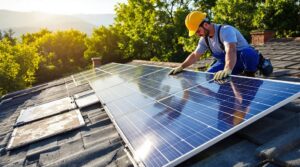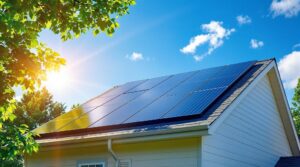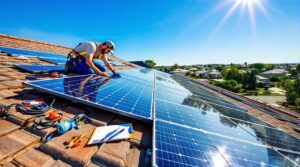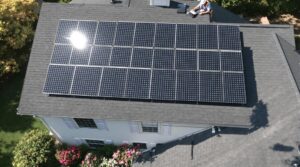Want your solar panels to work like a well-oiled machine? Let's dive into smart maintenance tips that'll keep your sun-catching warriors in top shape!
Think of your solar panels as athletes – they need regular care to perform their best. Start by giving them a gentle shower with deionized water in the early morning when they're cool (just like you wouldn't exercise in peak heat!). You'll want to check them every three months for tiny cracks or hot spots that could be zapping their energy-making powers.
Getting the angle right is crucial – aim for 30-45 degrees, kind of like positioning your beach chair for the perfect tan. Keep those pesky trees and bushes trimmed back; your panels need their personal space to soak up those rays efficiently.
I recommend using smart monitoring apps to track your panels' daily performance – it's like having a fitness tracker for your solar system! If storm damage occurs, don't hesitate to call in public adjusters who know the ins and outs of solar insurance claims.
Remember to keep a maintenance diary (yes, just like your car's service book) to track cleaning dates, energy output, and any repairs. By following these steps, you'll help your solar investment shine bright for years to come!
Key Takeaways
- Clean panels during cool hours using soft brushes and deionized water to prevent damage and maintain optimal performance.
- Monitor panels for physical defects like microcracks, snail trails, and hotspots during sunrise or sunset inspections.
- Schedule professional maintenance annually for electrical scans, thermal imaging, and connection box checks.
- Adjust panel angles 2-4 times yearly and maintain proper positioning for maximum sunlight exposure.
- Track daily energy production and document all maintenance activities, repairs, and performance changes with photos.
Regular Panel Cleaning and Debris Removal
Want your solar panels to shine their brightest? Let's talk about keeping these sun-catching superstars clean and debris-free!
Think of your solar panels like windows to the sun – when they're covered in dust, leaves, or nature's little surprises (yes, we're talking about bird droppings), they can't soak up all that precious sunlight. It's like wearing sunglasses on a cloudy day – not exactly optimal, right?
Getting your hands dirty (or rather, keeping your panels clean) is simpler than you might think. Here's the smart way to do it:
- Time it right: Early morning or evening is your sweet spot when panels are cool and cozy
- Use the right tools: Think soft-bristled brushes designed specifically for solar panels – treat them like the delicate tech they are
- Go gentle: No need to channel your inner pressure washer – soft touches prevent micro-scratches
- Choose wisely: Deionized water is your best friend, keeping those pesky mineral deposits at bay
Safety first, sunshine later! Always secure yourself properly when up on the roof, and wear shoes that grip like a gecko.
While you're up there, take a moment to scan for any cracks or loose connections – it's like giving your panels a quick health check-up.
Consistent maintenance pays off, as proper maintenance extends the lifespan of your solar panels by up to 5 years.
Monitoring System Performance and Output
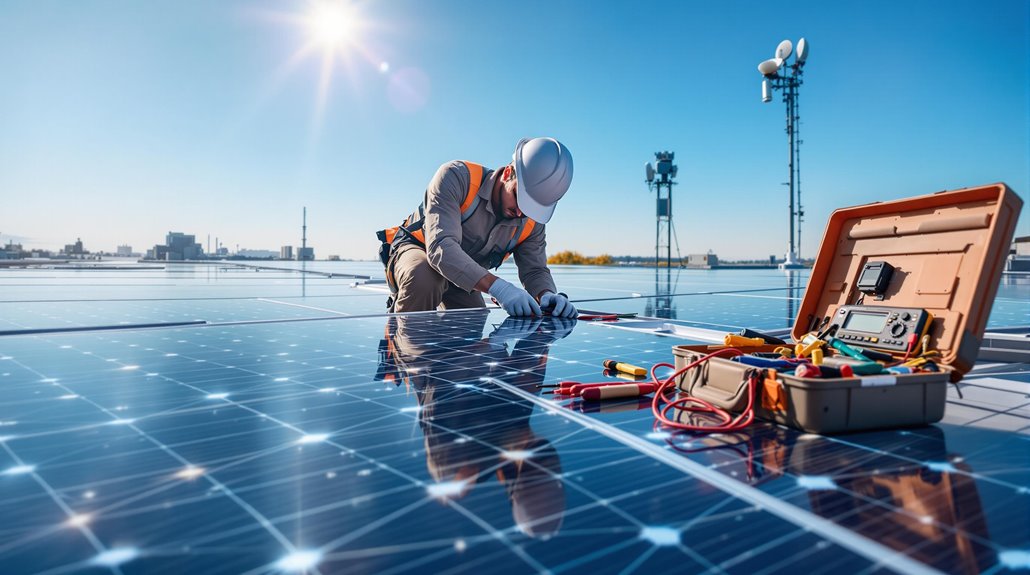
Solar system monitoring requires tracking daily energy production metrics through a data logging interface to establish baseline performance patterns.
Voltage and current measurements across different components help identify potential efficiency losses or malfunctions requiring attention.
Weather impact data, including temperature, cloud cover, and seasonal variations, provides essential context for evaluating system output against expected generation levels.
Premium panels demonstrate minimal efficiency loss of only 0.3% per year compared to standard installations.
Track Daily Energy Production
Solar Production Tracking: Your Power Plant's Daily Report Card
Ever wondered if your solar panels are living up to their sunny promises? Let's turn you into a solar detective with smart tracking strategies that'll keep your green energy game strong!
Think of your solar monitoring system as your home's energy fitness tracker. Just like counting steps, you'll want to keep tabs on these power-packed numbers:
| Time Frame | Power Detective's Checklist | Performance Signals |
|---|---|---|
| Daily | Energy Harvest (kWh) | Sun vs. Clouds Impact |
| Weekly | Golden Hours | Panel Health Score |
| Monthly | System Check-ins | Money Saved |
| Yearly | Solar Report Card | Investment Returns |
Your solar story unfolds in real-time through sleek apps and online dashboards – no more guessing games about your panels' performance. Imagine having a personal energy coach in your pocket, alerting you when your solar team needs a pep talk (or just a good cleaning).
By keeping score of your solar stats, you'll spot trends faster than a cloud passing over your panels. When production dips below your baseline, you'll know it's time for action. Regular check-ins help you maximize those sun-soaking hours and keep your energy harvest bountiful year-round.
Remember: a well-tracked solar system is a happy solar system, delivering clean energy and savings right to your doorstep!
Modern AI-powered optimization systems automatically adjust your panels' performance based on weather conditions to maximize energy production.
Check Voltage and Current
Want to become a solar system detective? Let's dive into the fascinating world of voltage and current measurements – your secret weapons for keeping those solar panels performing at their peak!
Think of voltage and current testing as giving your PV system a regular health check-up. Just like a doctor uses vital signs to diagnose your well-being, these electrical measurements tell us exactly how your solar setup is breathing and pumping energy.
When you monitor voltage across panels (like checking individual players on a team), you'll quickly spot which ones aren't pulling their weight.
But here's the kicker – you can't just jump in there with a multimeter! Safety first, solar warriors. Proper insulation and isolation are non-negotiable, kind of like wearing protective gear before stepping onto a construction site.
By comparing your readings to the manufacturer's playbook (specifications), you'll catch warning signs early – whether it's sluggish cells, loose connections, or an inverter throwing a tantrum.
The best part? Creating a measurement logbook is like building your solar system's medical history. It helps you spot efficiency dips before they become energy-draining disasters.
Remember: Regular electrical check-ups = longer-lasting solar system = more money saved in your pocket! 🌞
Professional inspections using infrared camera technology can reveal hidden issues that voltage testing alone might miss.
Monitor Weather Impact Data
Is Your Solar System Speaking to You Through the Weather? Listen Up!
Think of weather monitoring for your solar panels as keeping tabs on your system's daily mood swings.
Just like we perform better on sunny days, your photovoltaic setup has its own weather-related quirks that directly impact its performance.
Want to become a solar weather whisperer? Here's what you need to track:
☀️ Solar Irradiance: Your system's energy potential is like a bank account – the more sunshine you deposit, the higher your power returns.
🌪️ Storm & Wind Patterns: These are your system's stress tests. Understanding how your hardware handles nature's gym sessions helps prevent unexpected breakdowns.
🌧️ Rainfall Patterns: Mother Nature's free cleaning service! But how effective is it really for your panels?
🌡️ Temperature Fluctuations: Your panels are like athletes – they perform differently in various temperature zones.
Smart monitoring systems act like your solar setup's personal fitness tracker, collecting real-time data and sending alerts when something seems off.
By keeping an eye on these weather patterns, you're not just collecting data – you're developing a sixth sense for your system's health and performance.
Remember: Weather impact monitoring isn't just about numbers; it's about understanding your solar investment's language and responding to its needs before small hiccups turn into major headaches.
For optimal performance, keep in mind that your panels lose 0.3 to 0.5 percent of power generation capacity for each degree above 25°C.
Inspecting for Physical Damage and Cracks
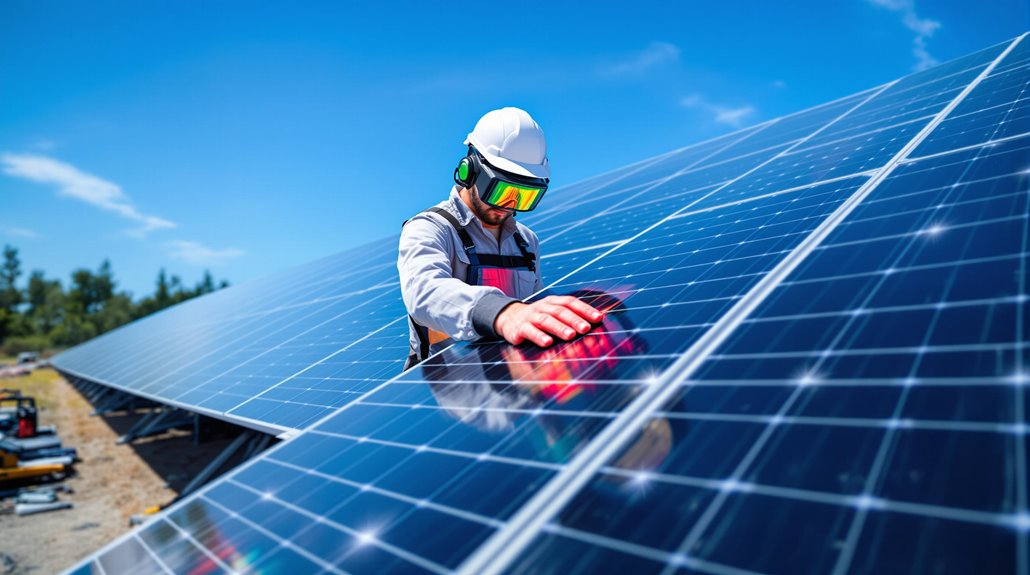
Regular visual inspection of solar panels requires methodical examination of the entire surface area to identify potential physical damage.
Technicians should check for telltale signs including microcracks, delamination, discoloration, and evidence of water intrusion beneath the glass surface.
These inspections are most effective during clear daylight conditions using proper safety equipment and specialized tools such as infrared cameras to detect hidden damage patterns.
Proper inspection and maintenance can help prevent weather-sealed components from failing and causing electrical system malfunctions.
Visual Inspection Best Practices
The Ultimate Guide to Solar Panel Visual Inspection: Protect Your Green Investment
Want to keep your solar panels performing at their peak? Let's dive into smart visual inspection strategies that'll help you spot issues before they become costly problems.
Think of visual inspection as your solar system's regular health check-up. Just like you'd notice a scratch on your car, catching early signs of panel wear can save you thousands in repairs.
Essential Inspection Checklist:
- Watch for the "Golden Hours" – Inspect panels during sunrise or sunset when oblique sunlight reveals subtle defects like microcracks
- Play "Spot the Difference" with mounting rails and panels – Any misalignment could signal loose hardware or structural stress
- Create your "Panel Portfolio" – Snap clear photos of irregularities (discoloration, bubbling, or scorch marks) to track changes
- Check your panel's "anchor points" – Examine mounting brackets for tight connections and rust formation
Pro tip: Schedule your visual checks every three months, but don't skip an extra look after storms or extreme weather events.
Keep a digital inspection log – it's like maintaining your solar panel's medical history, helping you identify patterns and predict potential issues.
Remember: Your eyes are your first defense against solar system problems. A methodical visual inspection today can prevent performance drops and safety risks tomorrow.
Regular inspection is crucial since dirty solar panels can reduce system efficiency by up to 20%.
Common Damage Warning Signs
Think of your solar panels as silent warriors, battling the elements day after day. Like any warrior, they'll show signs when they need help. Let's decode these distress signals together!
Snail trails might sound cute, but these dark, winding patterns creeping along cell edges are red flags you shouldn't ignore.
Imagine your panel's layers playing tug-of-war – that's delamination, where the once-tight layers start drifting apart. And those tiny microcracks? They're like spider webs across your cells, subtle but significant.
Watch out for the telltale brownish patches called hotspots – they're basically your panel's fever symptoms, pointing to electrical troubles beneath the surface.
The encapsulant (that's the clear stuff protecting your cells) might start looking like old yellowed paper or develop bubbles like a poorly applied phone screen protector.
Got water marks under the glass? That's as welcome as a leak in your roof! And if you spot burn marks near junction boxes, consider it your panel's version of sending up emergency flares.
Impact damage? Well, those star-shaped cracks tell the story of unfortunate encounters with anything from hail to fallen branches.
Pro tip: Make these checks part of your regular home maintenance routine. After all, wouldn't you rather catch these issues while they're whispering rather than waiting until they're screaming for attention?
Keep detailed maintenance records of any damage you find, as these will be essential for insurance claims and continued coverage.
Professional Annual Maintenance Checkups
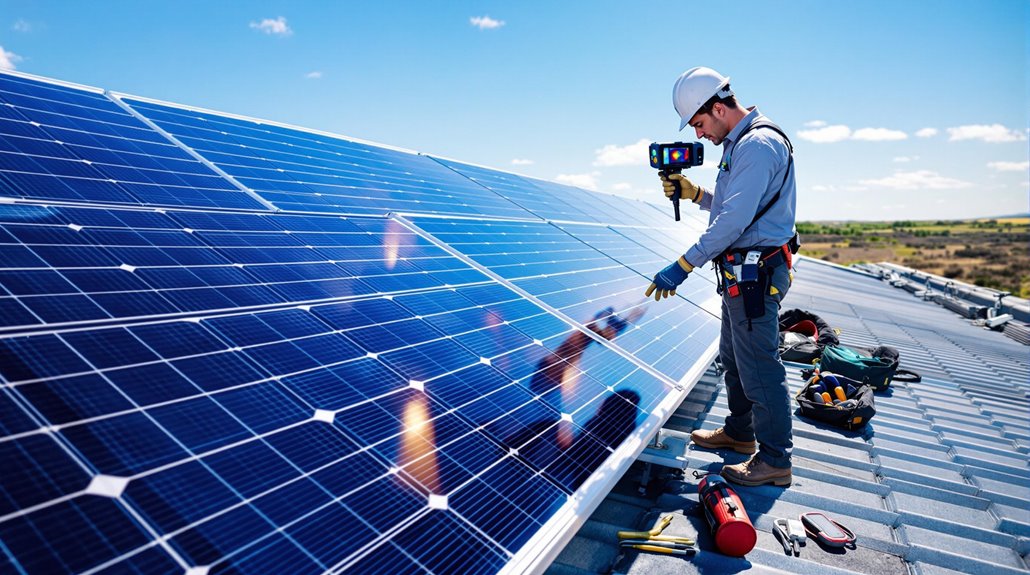
Think of Your Solar Panel System Like a High-Performance Car
Just as you wouldn't skip your car's annual service, your solar panels need their yearly checkup to keep soaking up those rays at maximum efficiency.
Let's dive into what makes these professional maintenance visits so crucial for your clean energy investment.
What Happens During Your Solar Checkup?
Imagine a solar detective squad coming to your home, armed with high-tech tools to ensure your system is performing at its absolute best. They'll:
- Run a comprehensive electrical health scan (think full-body checkup for your system)
- Use thermal imaging cameras to spot any underperforming panels
- Check all mounting points and weather seals
- Compare your system's current power output to its original specs
Why Should You Care?
These inspections aren't just another item on your home maintenance to-do list.
They're your insurance policy against unexpected problems and performance drops. Plus, they help you:
- Keep your warranty valid (yes, skipping maintenance can void it!)
- Catch small issues before they become expensive headaches
- Track your system's performance over time
- Maximize your energy production and savings
Pro tip: Schedule your annual checkup during spring or fall when weather conditions are mild, and technicians can work safely and efficiently.
Your solar investment deserves expert care to keep shining bright for years to come!
Remember: Regular maintenance isn't just about preventing problems – it's about optimizing your solar investment for the long haul.
With proper maintenance, you can expect your panels to maintain 80% output capacity for up to 40 years under standard performance warranties.
Addressing Inverter Issues and Updates
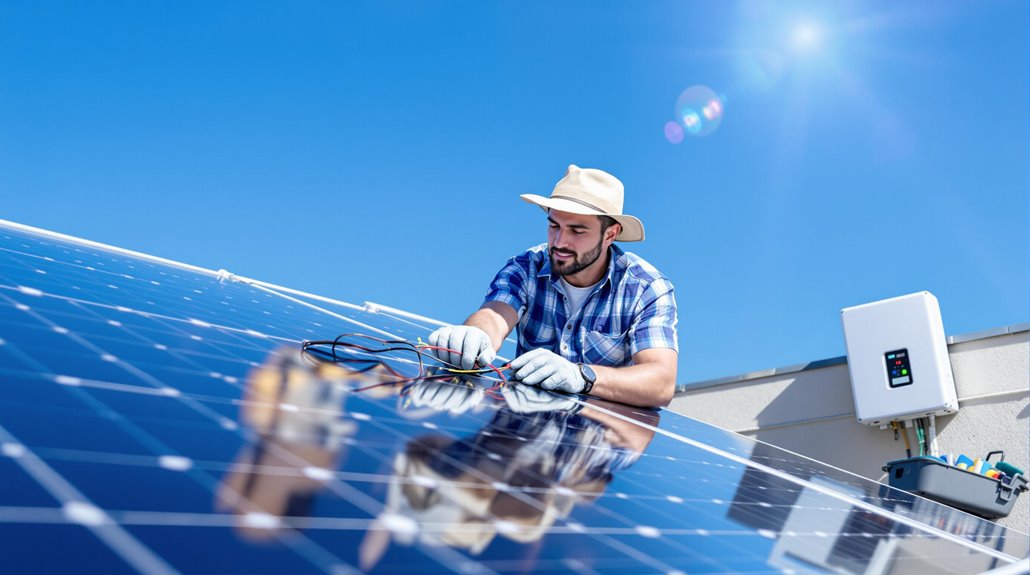
Is Your Solar Inverter Running at Its Best? Here's What You Need to Know
Think of your solar inverter as your home's energy conductor – orchestrating the symphony of power from your solar panels to your electrical system. Just like any sophisticated technology, it needs a bit of TLC to keep performing its best.
Let's dive into smart inverter maintenance that'll keep your solar system humming:
Keep Your Eyes on the Prize
- Monitor your inverter's performance through its display or smartphone app
- Watch out for unusual patterns or dips in energy production
- Think of error codes as your inverter's way of asking for help
Quick Troubleshooting Guide:
| When This Happens | Do This First |
|---|---|
| Error Messages Pop Up | Screenshot it and reach out to support |
| Screen Goes Dark | Power cycle and check wire connections |
| Energy Output Drops | Launch a system health check |
| System Keeps Restarting | Time for a firmware refresh |
Speaking of firmware – it's like giving your inverter a brain boost! Modern inverters can often update wirelessly, while older models might need a pro's touch. But here's the golden rule: never attempt repairs without cutting power to your system first.
Still scratching your head over inverter issues? Don't risk DIY fixes – a certified solar tech can diagnose and solve problems while keeping your warranty intact. Remember, your inverter is a sophisticated piece of tech that deserves expert care when things get complicated.
Pro Tip: Create a monthly reminder to check your inverter's performance metrics. Catching small issues early prevents bigger headaches later!
Keeping Solar Panel Records and Documentation
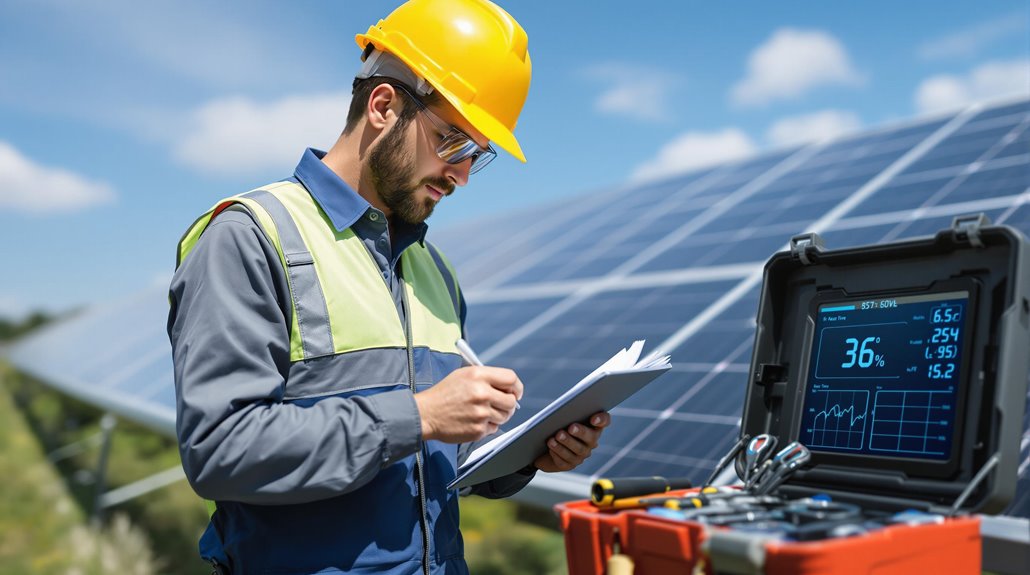
Maintaining thorough records of solar panel performance and repairs supports peak system management and efficiency. Monthly tracking of power generation data enables detection of declining output or maintenance needs before they become critical issues.
A detailed repair history log, including dates, parts replaced, and technician information, proves invaluable for warranty claims and future troubleshooting scenarios. Documentation is especially important for systems with 25-40 year lifespan to ensure optimal long-term performance monitoring.
Track Performance Data Monthly
Want to Supercharge Your Solar Panel's Performance? Track These Monthly Metrics!
Think of your solar panels as star athletes – they need regular performance checks to stay at the top of their game!
Monthly monitoring isn't just about number-crunching; it's your golden ticket to maximizing those sunshine dollars and catching any efficiency hiccups before they become energy-draining headaches.
Ready to become a solar monitoring pro? Here's what you should keep your eyes on:
Energy Production Champions
Track those kilowatt-hours (kWh) like a scoreboard! Compare them against last month's stats and your initial projections. Is your system hitting its energy goals, or is it falling short of the finish line?
Sun-Power Peak Performance
When does your system really shine? Monitor power output during sunny days, cloudy spells, and different daylight hours. It's like creating a performance diary for your solar investment.
Inverter Health Check
Your inverter is the brain of the operation – keep tabs on its efficiency scores and watch for any warning signals. Think of it as your system's regular health checkup.
Generation vs. Consumption Dance
How much of your energy needs are those panels actually covering? Understanding this ratio helps you fine-tune your energy habits and maximize solar benefits.
Pro Tip: Whether you're a spreadsheet wizard or prefer smart monitoring apps, consistent tracking is your best friend. Not only does it help optimize performance, but it's also your backup dancer when dealing with warranty claims or maintenance calls.
Document All Repair History
Why Your Solar Panel Repair Records Matter More Than You Think
Think of your solar system's repair history as its medical record – it tells the complete story of your panels' health journey! Let's dive into why keeping these records isn't just paperwork, but your golden ticket to smart solar ownership.
Track Your Solar System's Journey
| Date | Service Type | Action Taken |
|---|---|---|
| 01/15/23 | Inspection | Thermal imaging scan |
| 03/22/23 | Repair | Inverter replacement |
| 06/10/23 | Maintenance | Panel cleaning |
| 09/05/23 | Emergency | Storm damage repair |
| 12/01/23 | Upgrade | Monitoring system |
Ever wondered why professional solar installers obsess over documentation? It's like creating a timeline of your system's life story. Every check-up, repair, and upgrade adds another chapter to your solar panels' biography.
Smart Record-Keeping Tips:
- Snap before-and-after photos of repairs (your insurance company will thank you!)
- Log performance changes post-maintenance
- Keep track of who did what and when
- Store warranty paperwork alongside repair records
- Document weather conditions during emergency repairs
Want to level up your documentation game? Go digital! Modern solar monitoring apps let you attach repair notes, photos, and performance data in one place. It's like having your system's entire history in your pocket.
Weather Protection and Seasonal Preparations
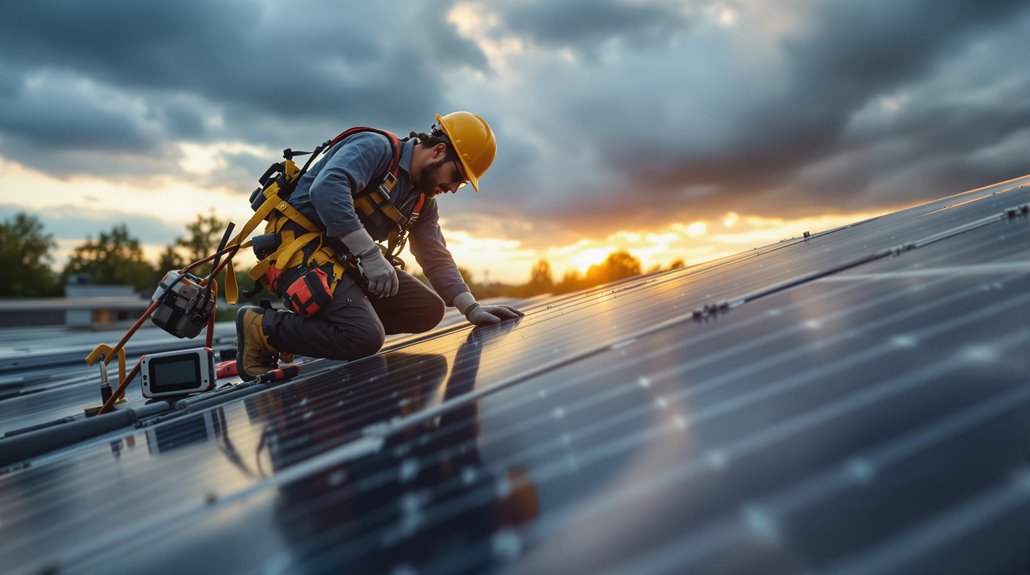
Protecting Your Solar Investment: Weather-Ready Tips for Every Season
Want to keep your solar panels performing like champions year-round? Let's dive into smart weather protection strategies that'll help you maximize your clean energy output, no matter what Mother Nature throws your way.
Think of your solar panels as star athletes – they need the right gear and preparation to perform their best in any conditions.
From scorching summers to frosty winters, here's your game plan for weather-proofing success:
Storm-Ready Strategies:
- Give those mounting brackets a pre-season check-up
- Shield your panels with weather-resistant coatings (like putting sunscreen on your panels!)
- Install smart snow-clearing systems before winter hits
- Set up seasonal tilt adjustments to catch those precious sun rays
Pro tip: Your local weather patterns are unique, so customize your protection plan accordingly. What works in sunny California might not cut it in snowy Minnesota!
Remember, prevention beats cure when it comes to solar panel care.
By staying one step ahead of the weather, you'll keep your energy production humming along smoothly and extend your system's lifespan. Have you checked your panels lately?
Quick action steps:
- Map out your area's weather challenges
- Schedule regular maintenance checks
- Install weather monitoring systems
- Keep emergency protection supplies handy
Your solar panels are tough, but they'll thank you for the extra TLC with years of reliable performance. Ready to weather-proof your solar investment?
Wiring and Connection Maintenance
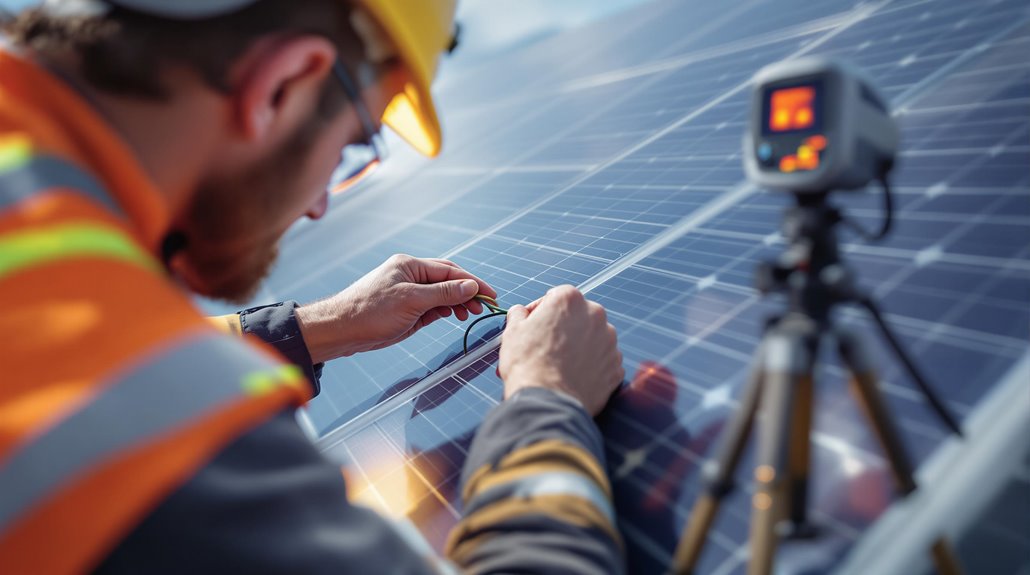
Is Your Wiring Playing it Safe? A No-Nonsense Guide to Connection Maintenance
Let's talk about keeping those crucial electrical connections in tip-top shape – because nobody wants a surprise short circuit! Think of your wiring system like the nervous system of your building; it needs regular check-ups to stay healthy.
What should you be looking out for? First, peek into those connection boxes. You're hunting for the usual suspects: corroded terminals (they look like they've been sprinkled with green salt), loose connections that wobble when they shouldn't, and insulation that's seen better days. If you spot any of these troublemakers, don't wait – get them replaced pronto!
Here's where it gets interesting: those soldered joints are like the handshakes between components. Over time, they can get stressed from hot-cold cycles, just like your muscles after a workout.
That's why you need a pro with a trained eye to check these connections regularly. They'll make sure your wire gauges are playing nice together and everything's snug as a bug (but not too snug – there's a specific torque for that!).
Smart maintenance pros use thermal imaging – think of it as a fever detector for your wiring. It catches those hot spots before they turn into hot problems.
They'll keep detailed notes about resistance values and connection health, just like a doctor's chart for your electrical system.
For those outdoor connections? They need special attention, like a good raincoat. Weather-tight seals are your best friends here. And when it's time for repairs, don't cheap out – marine-grade components are the way to go. It's like choosing the right tires for your car – you want the ones that'll keep you safe in any weather.
Remember: when it comes to electrical maintenance, cutting corners is like playing with fire – literally! Keep it professional, keep it regular, and keep it safe.
Optimizing Panel Angle and Positioning

Want to Turn Your Solar Panels into Energy-Harvesting Champions? Let's Talk Perfect Positioning!
Think of your solar panels as sunflowers – they thrive when they're perfectly positioned to catch those golden rays!
Getting the angle and direction just right isn't just smart; it's your ticket to maximum solar power production.
Did you know that the perfect panel setup can boost your energy yield by up to 30%? Here's your straightforward guide to nailing that optimal position:
Angle Magic:
- Your local latitude is your best friend – typically aim for 30-45 degrees
- Think seasonal: adjust your panels 2-4 times yearly as the sun plays hide and seek
- Remember, winter needs steeper angles, while summer loves it flatter
Direction Matters:
- Northern hemisphere? Point those panels south
- Down under? Flip it – north is your sweet spot
- Keep it clear of shadows – your panels need their daily 4-hour sunlight vitamin D!
Pro Tools of the Trade:
Solar pathfinders and digital inclinometers aren't just fancy gadgets – they're your precision positioning partners. Think of them as your solar panel's GPS system, guiding you to that energy-producing sweet spot.
Monitor & Maintain:
Track your power output like a fitness tracker for your panels.
When the numbers start dipping, it might be time for an angle adjustment tune-up. Just remember to double-check those mounting brackets – safety first!
Managing Shade and Vegetation Growth
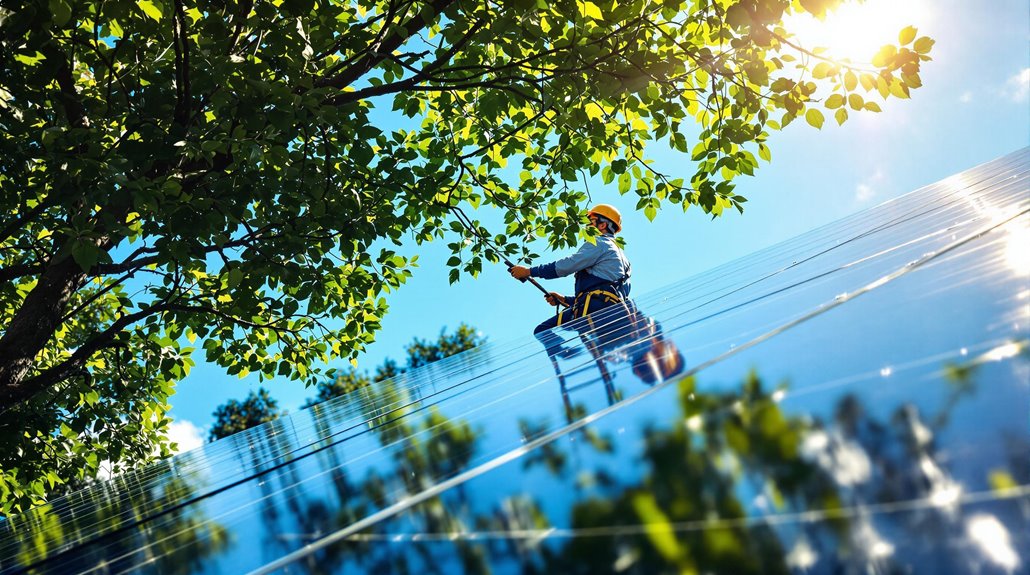
Want to keep your solar panels soaking up every ray of sunshine? Let's talk about winning the shade game!
Think of your solar array as a sunbather – it needs an unobstructed view of the sky to get that perfect energy tan. But just like unwanted beach umbrellas, nearby trees and vegetation can crash your solar panel's sun-catching party.
Smart shade management starts with keeping your eyes on the green giants around your system. Set up quarterly "shade patrols" to spot any sneaky branches or ambitious vines trying to photobomb your panels.
Remember, what looks like harmless greenery in winter can turn into a serious solar blocker once spring leaves pop!
Here's your shade-busting action plan:
- Trim overhanging branches before they become power-robbing bullies
- Create a "no-grow zone" around ground-mounted arrays
- Keep those gutters leaf-free (they're not autumn storage units!)
- Watch out for seasonal sun angles – Mother Nature's geometry matters
Pro tip: Don't play DIY lumberjack near power lines! Get certified arborists for the big trim jobs. They know exactly how to handle those high-reaching branches without turning your energy upgrade into an adventure story.
Benefits Of Public Adjusters For Solar Panel Home Insurance Claims & Questions
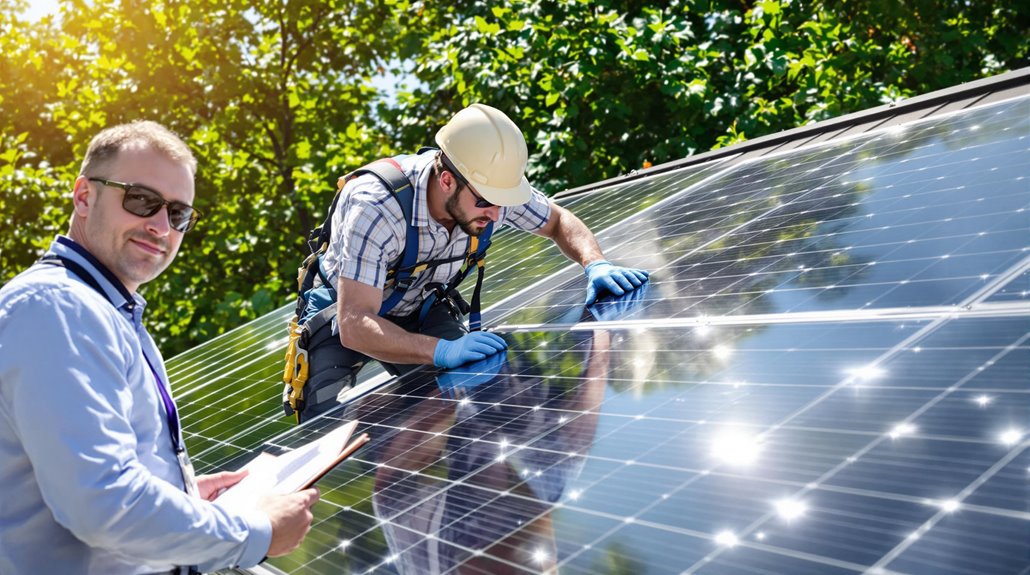
Public adjusters offer specialized expertise in solar panel insurance claims, providing objective damage assessments and handling complex policy provisions specific to renewable energy installations.
Their involvement typically leads to higher settlement amounts through detailed documentation of equipment damage, theft incidents, and installation issues, while maintaining professional relationships with qualified solar contractors and roofing specialists.
The adjuster's independent evaluation and claim management services streamline the entire process, ensuring homeowners receive fair compensation while avoiding common pitfalls in solar-related insurance claims.
Expertise In Solar Insurance Policies & Claims
Got Solar Panel Insurance Headaches? Let's Talk Claims Like a Pro!
When your solar investment takes a hit, navigating insurance claims can feel like solving a Rubik's cube blindfolded. That's where solar-savvy public adjusters become your secret weapon in the claims battlefield.
Think of public adjusters as your solar panel CSI team – they dive deep into every scratch, crack, and electrical hiccup of your system. They're the specialists who know exactly where to look and what documentation will make your claim bulletproof.
Why does this matter? Well, solar systems aren't your typical insurance claim. From high-tech inverters to sophisticated mounting systems, every component tells its own story. You'll want someone who speaks both "insurance" and "solar" fluently in your corner.
Here's what these solar claim wizards bring to the table:
- Detective-level inspection skills targeting both visible and hidden damage
- Deep understanding of renewable energy policy language (yes, it's a thing!)
- Up-to-the-minute knowledge of solar equipment costs and labor rates
- Expert negotiation tactics that factor in future performance impacts
Did you know? Self-managed solar claims often leave money on the table. Working with a specialized adjuster is like having a solar-savvy translator who ensures your insurance company understands the full scope of your loss.
Remember: Your solar system is more than just panels on a roof – it's a complex energy-generating investment that deserves expert attention when things go wrong. Don't let insurance complexities eclipse your right to fair compensation!
Expert Objective Damage & Theft Assessments
Did Your Solar Panels Take a Hit? Get Expert Eyes on the Damage!
When Mother Nature throws a tantrum or thieves target your solar investment, you need more than just a quick glance – you need a professional who speaks the language of solar systems. Think of public insurance adjusters as solar panel detectives, armed with high-tech tools and years of experience to crack the case of your damaged installation.
These solar specialists don't just spot the obvious cracks and missing panels – they dive deep into the technical nitty-gritty, uncovering hidden issues that could zap your system's performance.
Using state-of-the-art inspection methods and detailed photo documentation, they build an airtight case for your insurance claim.
Why go solo when you can have a pro in your corner? Insurance companies respect the thorough assessments these licensed experts provide. Their keen eye for distinguishing fresh damage from wear-and-tear can make a world of difference in your settlement.
While their 10-20% fee might raise eyebrows, consider this: represented claims typically see up to 800% higher payouts than DIY attempts.
Streamlined Claim Process
Want to Make Your Solar Panel Insurance Claims a Breeze?
Let's face it – dealing with solar panel insurance claims can feel like navigating a maze blindfolded. But don't worry, I've got your back!
Think of public adjusters as your personal GPS through the claims jungle, helping you map out the perfect route to maximum settlements.
Why You Need a Pro in Your Corner:
- Solar system assessments that leave no panel unturned (literally!)
- Crystal-clear documentation that speaks your insurance carrier's language
- Tech-savvy expertise to properly value your solar investment
- Strategic negotiation skills that turn evidence into excellent settlements
Picture this: While you're busy living your life, expert adjusters are meticulously photographing damage, crunching numbers, and wrestling with complex policy language.
They're like solar claim detectives, gathering every shred of evidence to build your case.
But here's the real game-changer – these pros understand the latest solar technology inside and out. They know exactly what your damaged equipment is worth and won't let insurance companies undervalue your claim.
Pretty neat, right?
Remember: Time is money in the claims world! A systematic approach keeps your claim moving forward, preventing those frustrating delays that can chip away at your settlement value.
Think of it as keeping your claim on a fast-track conveyor belt instead of stuck in weekend traffic.
Ready to turn your solar panel insurance claim from a headache into a victory? Let's get that process rolling!
Higher Claim Payouts & Settlements
Want to Get More Money for Your Solar Panel Damage Claim? Here's Why Public Adjusters Are Your Secret Weapon
Think of public adjusters as your personal claim champions – they're the pros who know how to turn a modest insurance settlement into something that truly reflects your solar system's worth. It's like having an expert chess player strategically moving pieces to secure your victory.
Did you know? Property owners working with public adjusters often see their solar damage settlements soar to levels 8 times higher than those going it alone. Pretty eye-opening, right?
These licensed claim wizards bring three game-changing skills to the table:
- Sharp-eyed damage detection that catches issues you might miss
- Deep-dive documentation that leaves no panel unturned
- Savvy negotiation tactics backed by real-world solar expertise
The best part? They're invested in your success – literally. Public adjusters typically earn 10-20% of your final settlement, so they're motivated to fight for every dollar your claim deserves.
Think of it as partnering with someone who only wins when you win.
Their encyclopedic knowledge of policy fine print and current market rates means they can spot opportunities for compensation that most property owners wouldn't even know existed. It's like having a GPS for navigating the complex maze of insurance claims.
Ready to maximize your solar damage claim? A public adjuster might just be your brightest investment yet.
High Quality & None-Biased Network Of Trusted Solar, Roofing, & Home Contractors
Looking for Trusted Solar and Home Contractors? Here's Your Stress-Free Solution!
Think of a public adjuster's contractor network as your personal home improvement matchmaker – connecting you with top-notch professionals who've earned their stripes in solar installation, roofing, and home restoration.
What makes this network special? These connections aren't built on kickbacks or hidden fees, but rather on something more valuable: proven excellence and fair deals.
Why tap into this golden network? Let's break it down:
✓ Quality Assurance: Every contractor has passed rigorous vetting (think Olympic-level standards for home services!)
✓ Zero Hidden Agendas: Recommendations based purely on merit – like getting advice from a trusted friend
✓ Smart Pricing: Contractors know they're under the watchful eye of adjusters, keeping those numbers honest
✓ Value Protection: These pros prioritize long-term relationships over quick profits
Ever wondered how to ensure you're not overpaying for home improvements? Having a public adjuster review your project is like having a savvy financial advisor in your corner.
They'll scrutinize those estimates and timelines, ensuring you get maximum bang for your insurance claim buck.
Pro Tip: When choosing contractors through this network, you're not just getting a service provider – you're gaining access to a carefully curated ecosystem of home improvement excellence. Isn't it time you experienced the difference?
About The Public Claims Adjusters Network (PCAN)
Think of PCAN as your insurance claim superhero squad! We're a nationwide network of state-licensed public adjusters who've got your back when property damage strikes.
Whether you're a homeowner dealing with storm damage or a business owner facing complex commercial claims, our experts across 40+ states know exactly how to navigate the insurance maze.
What makes us different? Well, joining our network isn't exactly a walk in the park. Every adjuster goes through a tough vetting process – kind of like American Idol, but for insurance pros!
We're talking detailed background checks, intense interviews, and annual performance reviews to ensure our members maintain the highest standards.
Ever wondered who's fighting in your corner when disaster strikes? Our adjusters are like property damage detectives, specializing in everything from hurricane damage to fire claims.
And just like you wouldn't trust your health to an unlicensed doctor, we make sure every PCAN member has up-to-date licenses and a spotless track record.
Looking for someone to translate that confusing insurance jargon? Our network connects you with the perfect adjuster for your specific situation.
It's like having a matchmaking service for insurance claims – we pair you with experts who speak your language and understand your unique challenges. No more wrestling with complex claims alone – we've got real people ready to help real people!



